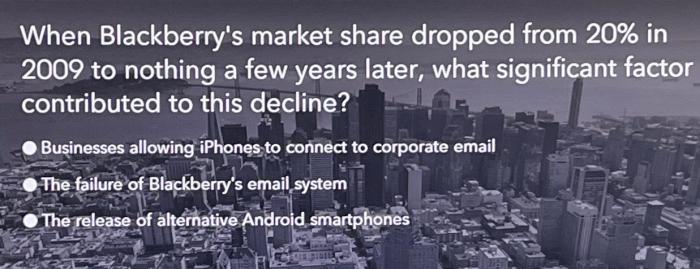The Rise and Fall of BlackBerry
BlackBerry, once a dominant force in the mobile phone market, has experienced a dramatic decline in recent years. Its story serves as a compelling case study of the rapid pace of technological innovation and the challenges of adapting to evolving consumer preferences.
BlackBerry’s Rise to Dominance
BlackBerry’s success was rooted in its early adoption of innovative features and its focus on a niche market. The company, initially known as Research In Motion (RIM), was founded in 1984 and quickly established itself as a leader in wireless communication technology.
BlackBerry’s popularity was driven by several key factors:
- Secure and Reliable Communication: BlackBerry devices were known for their robust security features and reliable email capabilities, making them popular among professionals and government agencies.
- Physical Keyboard: BlackBerry’s physical keyboards were a defining feature, offering a more tactile and efficient typing experience compared to early touchscreen smartphones.
- Push Email: BlackBerry’s push email technology allowed users to receive emails in real-time, a significant advantage over traditional email systems.
- Mobile Messaging: BlackBerry Messenger (BBM) was a revolutionary messaging platform that allowed users to communicate with each other instantly, even without a data connection.
BlackBerry’s dominance peaked in the mid-2000s, with a market share exceeding 20%. The company’s devices were widely seen as the gold standard for mobile communication, particularly for professionals and businesses.
BlackBerry’s decline was a gradual process, influenced by a combination of factors:
- The Rise of the Smartphone: The emergence of touchscreen smartphones, led by Apple’s iPhone and Google’s Android, marked a significant shift in consumer preferences. Touchscreen devices offered a more intuitive and user-friendly experience, and their app ecosystems provided access to a vast array of applications.
- Software Limitations: BlackBerry’s operating system (OS) lagged behind its competitors in terms of app development and user experience. The company struggled to keep pace with the rapid advancements in mobile software.
- Lack of Innovation: BlackBerry failed to adapt to the changing market dynamics and introduced new products that failed to capture the imagination of consumers. The company’s focus on its core strengths, such as security and physical keyboards, became a liability in a market increasingly driven by innovation and user experience.
- Market Share Erosion: As competitors gained ground, BlackBerry’s market share steadily declined. The company’s inability to attract new users and retain existing ones further accelerated its downfall.
BlackBerry, once a dominant force in the smartphone industry, has seen its market share dwindle to a mere 0.6%. This stark reality underscores the company’s struggle to remain relevant in a rapidly evolving technological landscape.
The current market share of BlackBerry devices paints a stark picture of the company’s diminished presence in the smartphone market. Here’s a comparison of BlackBerry’s market share with other major smartphone brands:
- Android: With a commanding market share of over 85%, Android remains the dominant operating system globally. Its open-source nature and vast app ecosystem have fueled its widespread adoption.
- iOS: Apple’s iOS holds a significant share of the market, primarily due to its user-friendly interface, strong security features, and premium brand appeal.
- BlackBerry: With a mere 0.6% market share, BlackBerry faces a challenging uphill battle to regain its former glory.
Implications for BlackBerry’s Future
BlackBerry’s declining market share has significant implications for its future. The company’s limited market presence makes it difficult to attract new customers and compete effectively against established players.
“The current market share reflects a decline in BlackBerry’s brand appeal and its inability to adapt to changing consumer preferences,” says [Name of an industry analyst], a technology expert at [Name of a reputable firm].
The shrinking market share also presents challenges for BlackBerry’s revenue generation and profitability. The company’s reliance on a limited customer base makes it vulnerable to fluctuations in demand and competition.
BlackBerry’s decline from a dominant player in the smartphone market to its current position with a meager 0.6% market share is a story of missed opportunities and a failure to adapt to the changing landscape. While several factors contributed to this downfall, the challenges BlackBerry faced in regaining market share can be broadly categorized into three key areas: intense competition, technological stagnation, and a lack of innovation.
The Competitive Landscape of the Smartphone Industry
The smartphone industry is a highly competitive landscape characterized by rapid technological advancements, aggressive marketing strategies, and a constant influx of new players. BlackBerry faced stiff competition from established players like Apple and Samsung, as well as emerging Chinese brands like Huawei and Xiaomi. These competitors offered a wider range of devices with superior features, better user interfaces, and more affordable prices. BlackBerry’s failure to keep pace with these competitors in terms of innovation and price competitiveness resulted in a gradual erosion of its market share.
Technological Advancements in the Smartphone Market
BlackBerry struggled to keep up with the rapid technological advancements in the smartphone market. While BlackBerry was initially known for its innovative keyboard-centric devices and secure operating system, it failed to adapt to the growing demand for touchscreen devices, powerful processors, and high-resolution displays. Apple’s introduction of the iPhone in 2007 marked a significant shift in the industry, emphasizing touchscreen interfaces and app ecosystems. Android, an open-source operating system, further intensified the competition, offering a platform for a wide range of devices at different price points. BlackBerry’s reliance on its proprietary operating system and its reluctance to embrace touchscreen technology put it at a disadvantage in this evolving market.
BlackBerry’s Struggles with Innovation
Despite its early success with the BlackBerry Messenger (BBM) platform, BlackBerry failed to capitalize on its strengths and introduce innovative features that could differentiate its devices from the competition. While competitors like Apple and Samsung invested heavily in research and development to introduce new features and functionalities, BlackBerry’s innovation pipeline remained stagnant. This lack of innovation resulted in a decline in consumer interest and a perception that BlackBerry devices were outdated and lacking in features.
BlackBerry’s Current Strategies
BlackBerry has undergone a significant transformation, shifting its focus from a dominant smartphone manufacturer to a software and services company. This strategic shift reflects the changing landscape of the mobile industry and BlackBerry’s efforts to remain relevant in a competitive market.
BlackBerry’s Current Business Model and Focus
BlackBerry’s current business model centers around providing software and services to businesses and governments. The company focuses on developing secure communication platforms, enterprise mobility management solutions, and embedded software for various industries. BlackBerry’s core offerings include:
* BlackBerry Enterprise Software: This suite of software solutions enables secure communication and device management for enterprises.
* BlackBerry QNX: A real-time operating system (RTOS) used in embedded systems for automotive, industrial, and aerospace applications.
* BlackBerry Spark: A secure and scalable IoT platform for connecting and managing devices and data.
* BlackBerry Cylance: An AI-powered cybersecurity platform that protects businesses from advanced threats.
BlackBerry’s Key Markets
BlackBerry’s primary markets include:
* Government: The company provides secure communication and device management solutions to government agencies worldwide.
* Enterprise: BlackBerry targets businesses seeking secure mobile solutions for their employees.
* Automotive: BlackBerry’s QNX operating system is used in automotive infotainment systems and advanced driver-assistance systems (ADAS).
* IoT: The company’s Spark platform is used for connecting and managing devices in various IoT applications.
Effectiveness of BlackBerry’s Current Strategies
BlackBerry’s current strategies have yielded mixed results. The company has experienced some success in securing contracts with governments and enterprises for its security-focused solutions. However, the overall market share for BlackBerry’s products remains relatively small.
Challenges:
* Competition: BlackBerry faces intense competition from established players like Microsoft, Cisco, and IBM in the enterprise software market.
* Shifting Mobile Landscape: The rise of Android and iOS has significantly reduced the market share for BlackBerry smartphones.
* Limited Consumer Appeal: BlackBerry’s current products are primarily targeted at businesses and governments, limiting their appeal to consumers.
Opportunities:
* Growing Demand for Security: As cyber threats become more sophisticated, the demand for secure communication and device management solutions is increasing.
* IoT Growth: The expanding IoT market presents opportunities for BlackBerry’s Spark platform and QNX operating system.
* Focus on Niche Markets: BlackBerry’s focus on specific industries, such as automotive and government, allows the company to leverage its expertise and build strong relationships with key players.
Despite the challenges, BlackBerry’s current strategies have positioned the company as a leading provider of secure communication and device management solutions for businesses and governments. The company’s focus on niche markets and its expertise in security offer opportunities for growth in the future.
The Future of BlackBerry
BlackBerry, once a dominant force in the mobile phone industry, has faced significant challenges in recent years, leading to a dramatic decline in its market share. However, the company has been exploring new strategies and focusing on niche markets. The question now is: can BlackBerry make a comeback and regain a significant market share?
The possibility of BlackBerry regaining a significant market share in the broader smartphone market is unlikely. The smartphone landscape has evolved dramatically, with Android and iOS dominating the market. These platforms have established ecosystems with vast app libraries, robust hardware, and a loyal user base. BlackBerry would need to overcome significant hurdles to compete effectively against these giants.
Leveraging Strengths in Niche Markets
While BlackBerry may not regain mainstream market dominance, it can leverage its existing strengths to thrive in niche markets. The company’s focus on security, privacy, and enterprise solutions positions it well for specific sectors.
- Government and Enterprise: BlackBerry’s focus on secure communication and data management makes it an attractive option for governments and large corporations seeking robust security features. The company has already established a strong presence in these sectors and can continue to capitalize on this niche.
- Specialized Industries: BlackBerry’s secure messaging platforms and ruggedized devices can cater to industries with specific requirements, such as healthcare, manufacturing, and logistics. These industries often demand reliable and secure communication, which BlackBerry can provide.
The Future of the Mobile Phone Industry
The mobile phone industry is constantly evolving, with new technologies and trends emerging regularly. The rise of foldable phones, 5G connectivity, and the increasing importance of artificial intelligence (AI) are shaping the future of the industry. BlackBerry will need to adapt and embrace these changes to remain competitive.
- Focus on Innovation: BlackBerry needs to invest in research and development to bring innovative products and services to market. This could include exploring new form factors, incorporating AI features, and developing cutting-edge security solutions.
- Strategic Partnerships: Collaborating with other companies can help BlackBerry access new technologies and expand its reach. Partnerships with hardware manufacturers, software developers, and service providers can provide valuable resources and market access.
Idc blackberrys marketshare at 0 6 – The future of BlackBerry is uncertain. While they may not be the market leader they once were, their focus on security and enterprise solutions could potentially carve out a niche for them in the ever-evolving mobile landscape. It’s a long road back to the top, but BlackBerry’s story is a reminder that even the most dominant players can be dethroned by innovation and change.
IDC reports BlackBerry’s market share at a measly 0.6%, a stark reminder that the once-mighty phone giant has fallen from grace. But while BlackBerry struggles, the tech world moves on, with new partnerships emerging to streamline our digital lives. For example, SwiftKey and Dashlane have teamed up to offer automatic password input, swiftkey dashlane partner up for automatic password input , making online security a breeze.
Perhaps BlackBerry could learn a thing or two from this collaboration, as they aim to reclaim their lost glory in the competitive smartphone market.
 Standi Techno News
Standi Techno News

